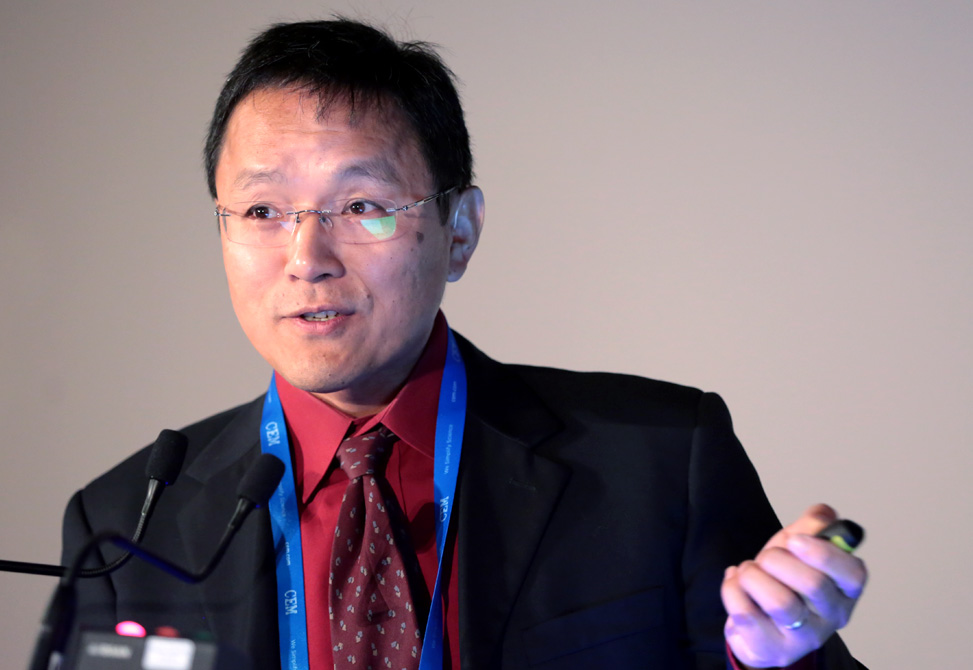Wenshe Liu
Texas A&M University
Talk Session: SESSION 4: SYNTHETIC METHODOLOGY FOR PEPTIDE AND PROTEIN SYNTHESIS
Date: Monday, June 13, 2022
Talk Time: 09:20 am - 09:40 am
Talk Title: Expressed Protein Ligation without Intein
We are a chemical biology research group with broad interests in integrating organic chemistry and biology for the understanding of basic biological processes, biotechnological innovation, and the development of novel therapeutics. The group is specialized in techniques including the genetic code expansion technique that allows the formation of artificial organisms with noncanonical amino acids, phage display with unnatural peptide libraries, and the synthesis of small molecules, peptides and proteins. Applications of these techniques include the understanding of epigenetic modifications on chromatin, the study of histone biology, phage-assisted drug discovery, and the development of small molecule therapeutics. Several ongoing projects are listed below.
COVID-19 Drug Discovery
SARS-CoV-2 is a newly emerged human coronavirus pathogen that has caused the COVID-19 pandemic. Rival only to the 1918 influenza pandemic, the COVID-19 pandemic has led to a profoundly catastrophic impact on the whole world. As of Jun 11th, 2020, the total amount of global COVID-19 cases have surpassed 7.4 million, of which more than 420,000 have succumbed to the virus and died. By forcing many countries and regions to hold lockdown, COVID-19 is driving the world economy into a recession. To alleviate catastrophic damages of COVID-19 on public health, society, and economy, finding timely treatment options is of paramount importance. Since Jan 2020, Liu group has been actively engaged in the identification of COVID-19 therapeutics. By targeting three essential proteins of SARS-CoV-2, Spike, 3CLpro and PLpro, both small molecules and peptide-based therapeutics have been developed. Some of these molecules have exhibited high potency in inhibiting SARS-CoV-2 in infected cells at nanomolar levels.
Expanding the Genetic Code
Pyrrolysine is the 22nd proteinogenic amino acid that was originally discovered in methanogenic archaea and some bacteria. Its coding involves amber codon, pyrrolysyl-tRNA synthetase, PylRS, amber suppressing tRNAPyl, and necessary enzymes for the synthesis of Pyl. Being a naturally occuring and well evolved amber suppression system, the PylRS-tRNAPyl pair has turned into an enormous research tool for undergoing the amber suppression-based noncanonical amino acid, ncAA, mutagenesis in both bacteria and eukaryotic cells to produce functionally unique proteins. As one of the original pioneers in the PylRS engineering research field, we have played an essential role in ascending the Pyl incorporation system as the most popular research tool for the ncAA mutagenesis. So far, close to 200 ncAAs have been genetically encoded using native or evolved Pyl systems. More than 80 of them were developed in Liu group. These ncAAs contain a large variety of functionalities with applications in both industry and academic research. We will continue our endeavor to develop novel genetic code expansion systems.
The Understanding of Epigenetic Functions of Posttranslational Histone Modifications
Using the genetic code expansion technique, we have enabled the synthesis of histones with a large variety of posttranslational lysine modifications. The access of histones with defined modifications has been a major obstacle of understanding epigenetic functions of nucleosomal modifications during cellular development and differentiation. Using delicately designed and engineered cells, our team has elegantly demonstrated the synthesis of large quantities of histones with site-specific lysine monomethylation, acetylation, propionylation, butyrylation, and crotonylation. In order to access to histones with lysine dimethylation, a sophisticated system that couples the genetic incorporation of a noncanonical amino acid and sequential bioorthogonal reactions was designed and published recently.
Moreover, we have devised a versatile method for the synthesis of histones potentially with any kind of lysine acylations. Methods developed in our group have allowed the synthesis of histones site-specifically with most lysine modifications. Using these developed approaches, we have demonstrated the constitution of nucleosomes site-specifically with lysine modifications in their histones and successfully applied these selectively modified nucleosomes to investigate functions of epigenetic erasers such as histone deacetylases. With our unique tools available, we are working toward to use Cryo-EM to structurally characterize functions of lysine modifications in regulating the nucleosome structure and recognition of nucleosome modifications by epigenetic erasers and readers.
Phage-Displayed Unnatural Peptide Libraries for Drug Discovery
The production of M13 phages in E. coli, a popular host for the ncAA mutagenesis technique makes it possible to merge the two techniques. Our exploration in this new and relatively applied research direction has led to the development of two novel techniques, with one being the construction of genetically encoded, phage-displayed cyclic peptide libraries, and the other the active site-directed ligand evolution technique, ADLE, for phage display. Cyclization is a typical approach to impart structural rigidity to peptides for improved binding to targets, higher resistance to proteolysis, and potentially better cell permeability. Cyclic peptides can be selected from phage displayed cyclic peptide libraries.
To circumvent limits related to existing approaches for the generation of phage-displayed cyclic peptides, we invented a technique in which a genetically encoded electrophilic ncAA was used to undergo a proximity-driven cyclization reaction with a nearby cysteine to generate phage-displayed cyclic peptide libraries. We have also combined the ncAA mutagenesis and phage display to create the ADLE technique. In ADLE, a chemical warhead with a known capability to bind a target active site is integrated into a ncAA that is genetically incorporated into a phage displayed sequence-randomized peptide library. During selection against the target, the binding of the ncAA to the target active site allows for a rationally designed interaction to guide the flanking residues in phage-displayed peptides toward the active site, increasing the probability that a given selection produces a productive, highly potent inhibitor. We are applying both techniques to the identification of potent inhibitors for both COVID-19 and cancer targets such as histone deacetylases.
Proteins with a functionalized C-terminus such as a C-terminal thioester are key to the synthesis of larger proteins via expressed protein ligation. They are usually made by recombinant fusion to intein. Although powerful, the intein fusion approach suffers from premature hydrolysis and low compatibility with denatured conditions.
To totally bypass the involvement of an enzyme for expressed protein ligation, here we showed that a cysteine in a recombinant protein was chemically activated by a small molecule cyanylating reagent at its N-side amide for undergoing nucleophilic acyl substitution with amines including a number of L- and D-amino acids and hydrazine. The afforded protein hydrazides could be used further for expressed protein ligation.
We demonstrated the versatility of this activated cysteine-directed protein ligation, ACPL, approach with the successful synthesis of ubiquitin conjugates, ubiquitin-like protein conjugates, histone H2A with a C-terminal posttranslational modification, RNAse H that actively hydrolyzed RNA, and exenatide that is a commercial therapeutic peptide.
The technique, which is exceedingly simple but highly useful, expands to a great extent the synthetic capacity of protein chemistry and will therefore make a large avenue of new research possible.





